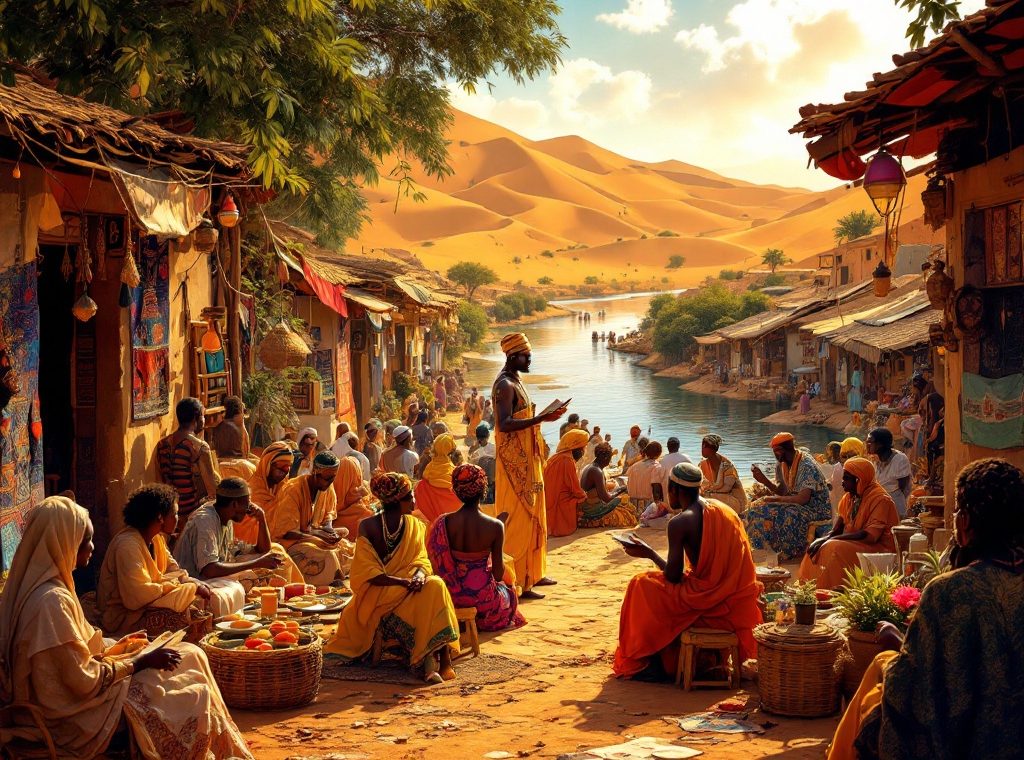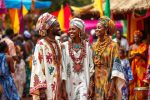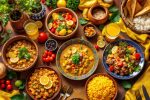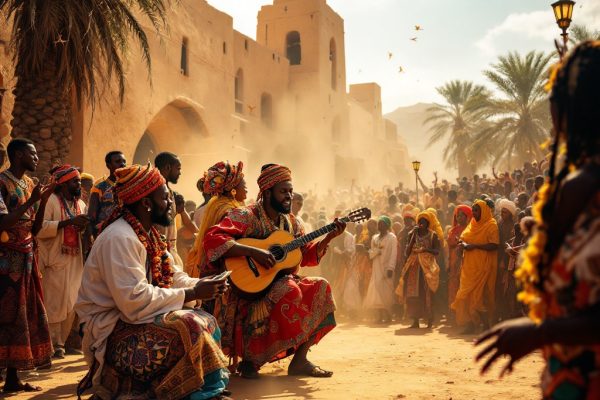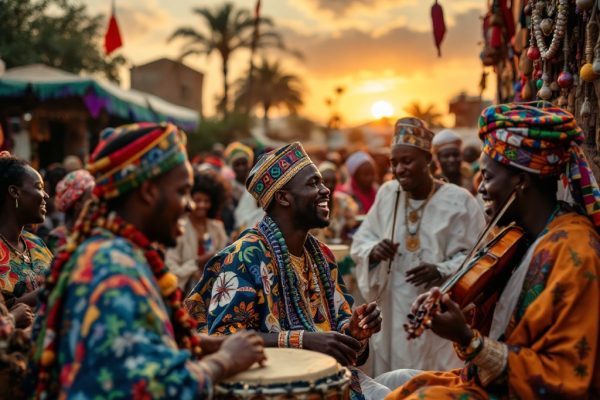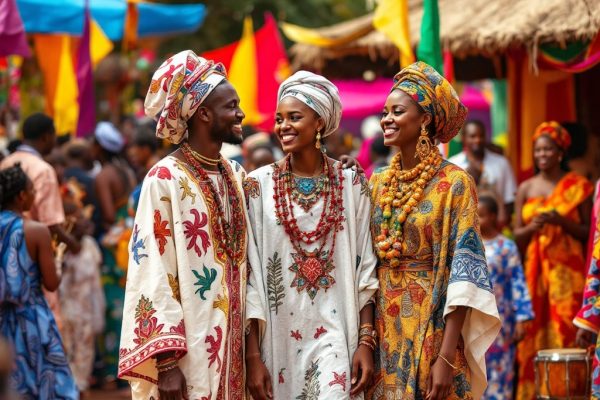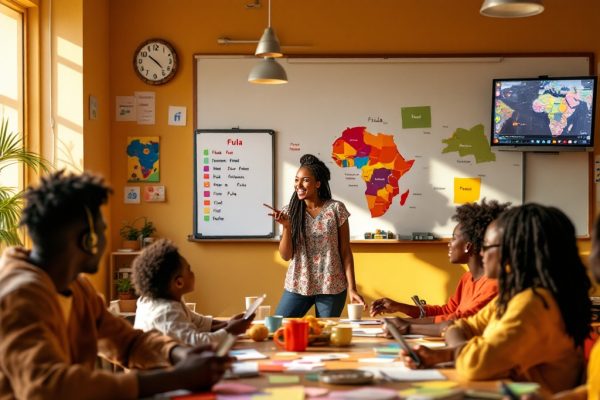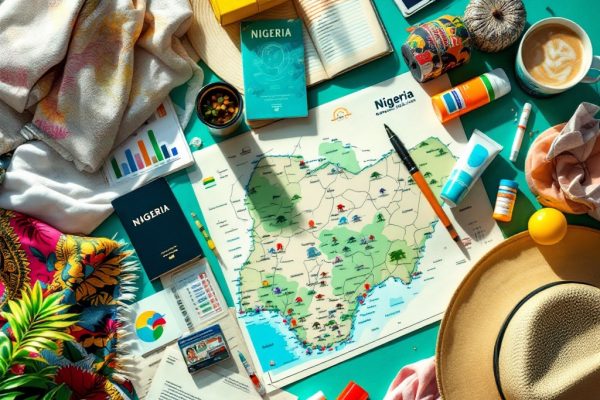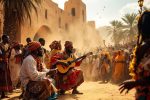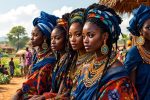Understanding Mali Culture and Traditions: A Short Guide
Journey to Mali, a West African nation brimming with rich history and diverse cultures. From the ancient empires of Ghana, Mali, and Songhai to the vibrant traditions of the Bambara, Fulani, Dogon, and Tuareg people, discover a land shaped by the Sahara Desert and the Niger River. Explore the concept of “Fama,” emphasizing respect and community, and the interplay of Islam with indigenous beliefs. Delve into Mali’s languages, from French to Bambara, and the captivating role of griots, the esteemed storytellers. Experience the vibrant festivals, savor the flavors of Maafe and Tigadegena, and witness the artistry of bògòlanfini cloth and intricate wood carvings. Uncover the heart of Mali’s cultural tapestry – explore its captivating story.
Important information
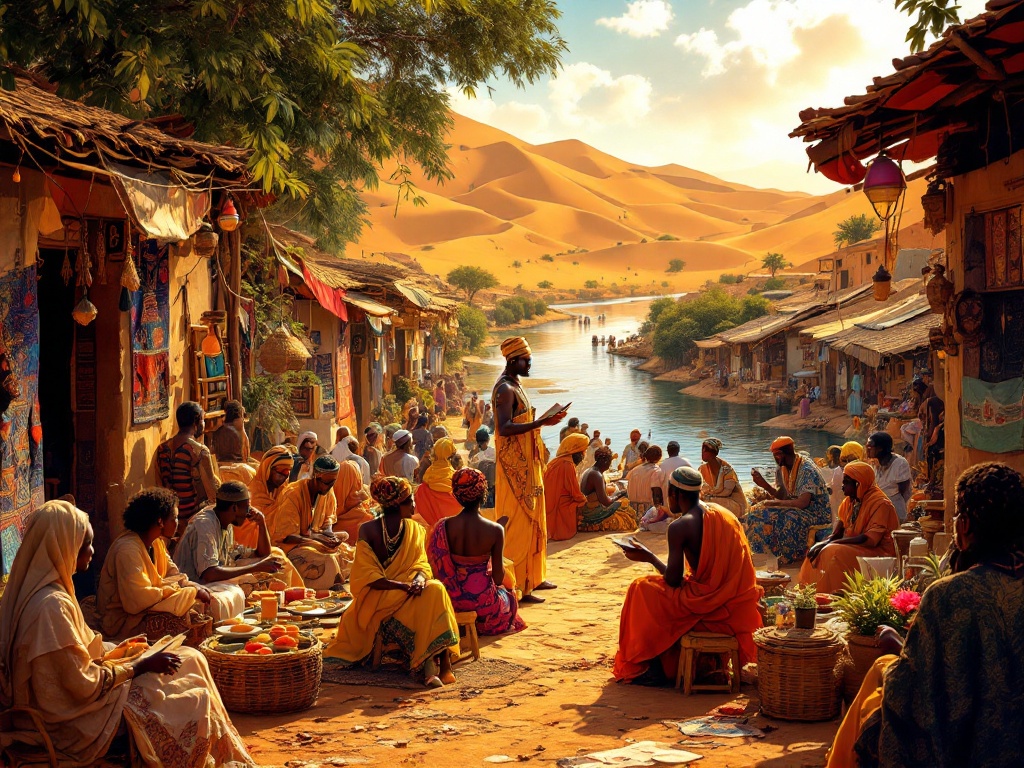
- Mali is a diverse nation with a rich history shaped by empires like Mali, Ghana, and Songhai, and its cultural landscape is influenced by various ethnic groups, including the Bambara, Fulani, Dogon, and Tuareg.
- Islam is the dominant religion, but traditional African religions, often incorporating animist beliefs, are also practiced, creating a unique spiritual blend.
- French is the official language, but Bambara serves as a common tongue, and numerous other national languages contribute to Mali’s linguistic diversity.
- Malian culture emphasizes respect for elders, community values (Fama), and strong family ties, exemplified by the playful cousin relationship known as “sanankuya.”
- Mali boasts vibrant artistic traditions, including music (with instruments like the kora, ngoni, and balafon), textiles (such as bògòlanfini mud cloth), and wood carving (especially masks and sculptures).
Mali: A Land of Rich History and Cultural Diversity
Mali, a West African nation bordered by countries like Algeria and Niger, is a melting pot of ethnicities. These include the Bambara, Fulani, Dogon, and Tuareg. Each group contributes to the nation’s vibrant cultural tapestry, woven from ancient empires, unique traditions, and the concept of “Fama.” Fama emphasizes respect for tradition and community values. This shared national identity is further enriched by Mali’s diverse geography, with the Sahara Desert to the north and the Niger River flowing through the south. These contrasting landscapes have shaped settlement patterns, livelihoods, and contributed to the country’s rich cultural complexity.
Historical Empires and Their Influence
The Mali Empire, a dominant force in West Africa, profoundly shaped the region’s history before colonialism. As a key player in the trans-Saharan trade, Mali fostered Islamic scholarship, leaving an enduring legacy, particularly under the reigns of Mansa Musa and Sundiata Keita. Other empires, such as Ghana and Songhai, also contributed significantly to the region’s cultural tapestry, stimulating intellectual and economic exchange while promoting growth and interconnectedness.
Diverse Ethnic Groups and Harmony
Mali’s rich cultural tapestry is woven from many ethnic groups, including the Bambara, Fulani, Dogon, and Tuareg. Their diverse traditions contribute to a shared national identity while fostering social harmony through interactions. This harmony is embodied in the concept of “Fama,” which emphasizes respect for established customs and community values, playing a vital role in Malian culture.
Languages and Communication in Mali
While French is Mali’s official language, Bambara is the most commonly spoken native tongue, acting as a lingua franca for much of the population. In 2023, thirteen other national languages were also granted official status, including Fula, Dogon, Malinke, and Soninke. Although French is widely understood, knowing basic local phrases, such as Bambara greetings, demonstrates cultural respect and fosters positive interactions. Mali’s diverse ethnic groups, including the Bambara, Fulani, Dogon, and Tuareg, appreciate even a small effort to speak their language.
The Role of French and Indigenous Languages
French is the official language of Mali, used in government, education, and business. However, indigenous languages such as Bambara, Fulfulde, Dogon, and Songhay are important within local communities, preserving cultural heritage and enriching Mali’s linguistic diversity.
Oral Traditions and the Influence of Griots
In Mali, griots, also known as “jelis,” are esteemed storytellers, musicians, and historians. They preserve history through spoken word, song, and instruments like the kora, sharing genealogies and vital cultural knowledge. These keepers of Mali’s rich oral traditions play a crucial role in their communities.
Religious Practices and Beliefs
Mali’s religious landscape is dominated by Islam, with over 90% of the population adhering to the Sunni branch. However, traditional African religions, often incorporating animist beliefs, continue to flourish. These indigenous faiths are particularly prevalent among groups like the Dogon, Malinke, and Bambara. This unique interplay of Islamic and indigenous beliefs profoundly shapes Malian society, influencing social customs, community life, and cultural expression. A small Christian community also exists within the country.
Islam in Mali
Islam’s influence is evident in Mali’s architecture, legal systems, and daily customs. Mosques serve as vital community hubs, and Islamic holidays are major cultural events. Islamic teachings provide guidance in everyday life.
Traditional African Religions
Traditional African religions remain significant, emphasizing ancestor reverence, spirit worship, and a deep connection with nature. Animist beliefs, focusing on the spiritual power of the natural world, are often interwoven with these practices. These traditions are kept alive through storytelling, rituals, and ceremonies, enriching Mali’s diverse cultural landscape.
Islam and Its Cultural Significance
Islam is deeply interwoven with Malian life, influencing daily routines and shaping social structures. Many Malians actively practice their faith through daily prayers and fasting during Ramadan. Mosques serve as vital community hubs, offering spaces for social gatherings and education. Core Islamic values, such as charity and community support, are deeply ingrained in Malian society, guiding interactions and traditions.
Traditional African Religions and Animist Beliefs
Mali’s religious landscape is a vibrant tapestry woven with ancient traditions and Islamic faith. Many Malians practice indigenous African religions, often rooted in animism, the belief that spirits inhabit the natural world. These spirits reside in elements like trees, rocks, and water. Ancestor veneration and rituals aimed at appeasing the spirits are also central to these beliefs, exemplified by the Dogon people and their distinctive cosmology. While Islam is the dominant religion, these traditional practices, particularly in rural areas, contribute to Mali’s rich spiritual diversity.
Traditional Customs and Etiquette
Respect for elders is fundamental to Malian culture, reflecting a deep-seated emphasis on community values like collectivism and mutual support. This translates into a society where helping one another is simply a way of life.
Mali is also renowned for its hospitality. Guests are greeted warmly and treated to traditional dishes like maafe and tigadegena. Sharing a meal is a powerful symbol of friendship, and expressing gratitude for this generosity demonstrates respect.
Strong family ties, particularly the importance of cousins, further characterize Malian society. The concept of sanankuya, a playful, joking relationship between cousins, fosters camaraderie and represents a unique aspect of their rich cultural heritage.
Respect for Elders and Community Values
In Mali, elders are highly revered for their invaluable wisdom and experience. This reverence profoundly influences decisions and nurtures social harmony. Community life emphasizes unity and cooperation, with mutual support as a cornerstone. Proverbs, stories, and traditions transmit these vital values across generations.
Cousinage and the Concept of Sanankuya
Sanankuya, a Bambara term, signifies special joking relationships between cousins, fostering social harmony through playful interactions. This lighthearted teasing and banter strengthens family bonds and a sense of belonging. Furthermore, sanankuya helps resolve conflicts and reinforces kinship ties in Mali.
Malian Festivals and Celebrations
Mali’s festivals are a vibrant expression of religious and cultural traditions. Islamic holidays are deeply significant, especially the joyous celebration concluding Ramadan. Families don their finest clothes, exchange food gifts, and gather for elaborate feasts. Tabaski, the Feast of the Sacrifice, commemorates Abraham’s devotion with prayers and livestock sacrifices.
Religious Festivals
Islamic holidays hold deep meaning, particularly the joyous celebration marking the end of Ramadan. Families dress in their finest attire, exchange gifts of food, and gather for elaborate feasts. Tabaski, the Feast of the Sacrifice, commemorates Abraham’s devotion with prayers and the sacrifice of livestock.
Cultural Festivals
Mali’s cultural festivals are equally captivating. The Festival au Désert offers a glimpse into Tuareg traditions with music, dance, and camel races. The Fête des Masques dazzles with vibrant masks and energetic dances. The unique Cattle Crossing Festival celebrates the seasonal livestock migration.
Festival au Désert: This festival provides a platform for cultural exchange, uniting Tuareg tribes with global visitors. It showcases music, dance, and thrilling camel races.
Fête des Masques: This festival is known for its vibrant masks and energetic dances, offering a unique cultural experience.
Cattle Crossing Festival: This unique festival celebrates the seasonal migration of livestock.
Ségou Festival: A showcase of Malian artistry, including music, dance, and captivating storytelling.
National holidays such as Armed Forces Day in January and Independence Day on September 22nd are marked with patriotic parades and speeches.
Islamic Holidays: End of Ramadan, Feast of the Sacrifice
Mali, a predominantly Muslim nation, vibrantly celebrates Islamic holidays. Eid al-Fitr marks the joyous culmination of Ramadan, a month of fasting and reflection. Families don new attire, share festive meals, and offer prayers. Eid al-Adha, the Feast of the Sacrifice, commemorates Abraham’s devotion and willingness to sacrifice his son. This deeply significant holiday involves communal gatherings, feasts, prayers, and the traditional sacrifice of a sheep.
Cultural Festivals: Fête des Masques, Cattle Crossing Festival
Fête des Masques features masked dancers embodying spirits and ancestors, a potent display of cultural heritage.
Every December in Diafarabe, the Cattle Crossing Festival unfolds. This is a communal event symbolizing prosperity and the Fulani people’s deep connection to their herds. This vibrant celebration also includes cultural performances and lively competitions.
Festival au Désert and Other Celebratory Events
The renowned Festival au Désert, typically held near Timbuktu, celebrates the rich musical heritage of the Tuareg people and other Malian communities. Attracting both locals and tourists, this festival showcases a vibrant blend of traditional and contemporary music, dance, and cultural displays. Mali’s diverse celebrations often intertwine traditional African religions with Islamic practices, featuring unique ceremonies, rituals, and artistic performances. Various ethnic groups contribute their own distinct traditions to these events. One prominent example is Tabaski, also known as Eid al-Adha, a major Islamic holiday celebrated across Mali with prayers, animal sacrifice, and shared feasts.
The Arts in Malian Culture
Mali’s vibrant cultural scene is renowned for its captivating music and dance. Traditional instruments like the kora, ngoni, and balafon produce mesmerizing melodies, often accompanying dances that enhance storytelling and musical performances. Legendary musicians such as Salif Keita, Oumou Sangaré, and Ali Farka Touré have brought international recognition to these rich traditions. Beyond music, Malian artistry flourishes in textiles and wood carving. The intricate designs of bògòlanfini, or mud cloth, are celebrated for their unique beauty. Skilled artisans also craft elaborate masks, sculptures, and decorative objects from wood. These art forms transcend mere aesthetics; they embody Malian history, beliefs, and social structures. Masks, for example, play a crucial role in ceremonies and rituals, powerfully expressing the heart of Malian culture.
Music and Dance: Instruments, Artists, and Traditions
Music and dance are integral to Malian culture, serving as powerful expressions of joy, storytelling, and community building. Traditional instruments create the unique sounds of Malian music. The kora, a 21-string bridge-harp, produces a distinctive sound. The ngoni (lute) and balafon (xylophone) also contribute to Mali’s rich musical tapestry. These instruments accompany various dances and songs, often celebrating harvests, historical events, and social themes. Renowned Malian musicians such as Salif Keita and Oumou Sangaré have achieved global recognition for their contributions to these musical traditions. These traditions are carefully passed down through families, preserving Mali’s vibrant cultural heritage.
Textiles and Wood Carving: Bògòlanfini, Masks, Sculptures
Malian artistry thrives in textiles like Bògòlanfini (mud cloth), featuring hand-painted designs crafted with fermented mud and natural dyes. Wood carvings also hold immense cultural significance, ranging from ritual masks to sculptures depicting spirits and ancestors. These art forms offer a glimpse into Mali’s rich heritage and spiritual beliefs. The Dogon people, known for their intricate masks and detailed granary doors, exemplify this artistic depth. Similarly, the Bambara people utilize Tyiwara masks in agricultural celebrations. These diverse artistic traditions are imbued with profound meaning, reflecting the spiritual and cultural values of the Malian people.
Malian Cuisine: A Taste of Tradition
Malian cuisine offers a delicious exploration of traditional flavors. Savor Maafe, a rich peanut stew simmered with meat (chicken, beef, or lamb), tomatoes, onions, and peanuts. Another must-try is Tigadegena, a hearty pasta dish often combined with meat and vegetables. Finally, experience couscous, a West African staple of steamed semolina served with a variety of sauces and meats. These diverse dishes showcase Mali’s vibrant culinary heritage and reflect its varied agricultural landscape through regional variations.
Traditional Dishes: Maafe, Tigadegena, Couscous
Maafe is a rich peanut stew that combines meats like chicken or lamb with hearty vegetables in a flavorful peanut-based sauce. Tigadegena, a grilled meat dish, often features beef or lamb marinated in spices and cooked over an open fire. A frequent accompaniment to these dishes is couscous, steamed semolina grains served with stews and sauces. These culinary delights showcase Mali’s rich food traditions.

